A Deep Learning Model for NOx Emissions Prediction of a 660 MW Coal-Fired Boiler Considering Multiscale Dynamic Characteristics
Abstract
1. Introduction
2. Description of the Research Object
2.1. The Studied Boiler
2.2. Variables Selection
3. Methodology
3.1. Data Preprocessing
3.1.1. Data Normalization
3.1.2. Auxiliary Variables Determination
3.2. Multiscale Graph Convolutional Deep Learning Network
3.2.1. Data Embedding
3.2.2. Scale Identification
3.2.3. Multiscale Adaptive Graph Convolution
3.2.4. Multihead Attention Mechanism
3.3. Evaluating Indices
4. Results and Discussion
4.1. Analysis of Auxiliary Variables Determination
4.2. Comparison with Other Algorithms
4.3. Evaluation of Multistep Prediction Performance
5. Conclusions
Author Contributions
Funding
Institutional Review Board Statement
Informed Consent Statement
Data Availability Statement
Conflicts of Interest
References
- Yue, H.; Worrell, E.; Crijns-Graus, W.; Zhang, S. The potential of industrial electricity savings to reduce air pollution from coal-fired power generation in China. J. Clean. Prod. 2021, 301, 126978. [Google Scholar] [CrossRef]
- Wu, Z.; Zhang, Y.; Dong, Z. Prediction of NOx emission concentration from coal-fired power plant based on joint knowledge and data driven. Energy 2023, 271, 127044. [Google Scholar] [CrossRef]
- Liu, Y.; Zhou, J.; Fan, W. A novel robust dynamic method for NOx emissions prediction in a thermal power plant. Can. J. Chem. Eng. 2023, 101, 2391–2402. [Google Scholar] [CrossRef]
- Qiao, J. A novel online modeling for NOx generation prediction in coal-fired boiler. Sci. Total Environ. 2022, 847, 157542. [Google Scholar] [CrossRef]
- Zhu, Y.; Yu, C.; Fan, W.; Yu, H.; Jin, W.; Chen, S.; Liu, X. A novel NOx emission prediction model for multimodal operational utility boilers considering local features and prior knowledge. Energy 2023, 280, 128128. [Google Scholar] [CrossRef]
- Song, M.; Xue, J.; Gao, S.; Cheng, G.; Chen, J.; Lu, H.; Dong, Z. Prediction of NOx Concentration at SCR Inlet Based on BMIFS-LSTM. Atmosphere 2022, 13, 686. [Google Scholar] [CrossRef]
- Chen, S.; Yu, C.; Zhu, Y.; Fan, W.; Yu, H.; Zhang, T. NOx formation model for utility boilers using robust two-step steady-state detection and multimodal residual convolutional auto-encoder. J. Taiwan Inst. Chem. Eng. 2024, 155, 105252. [Google Scholar] [CrossRef]
- Yin, G.; Li, Q.; Zhao, Z.; Li, L.; Yao, L.; Weng, W.; Zheng, C.; Lu, J.; Gao, X. Dynamic NOx emission prediction based on composite models adapt to different operating conditions of coal-fired utility boilers. Environ. Sci. Pollut. Res. 2022, 29, 13541–13554. [Google Scholar] [CrossRef]
- Tang, Z.; Wang, S.; Li, Y. Dynamic NOX emission concentration prediction based on the combined feature selection algorithm and deep neural network. Energy 2024, 292, 130608. [Google Scholar] [CrossRef]
- Wang, Z.; Zhou, Y.; Zhu, Y.; Yu, H.; Fan, W. Forecast of NOx Emissions for a 660 MW Coal-Fired Boiler with Multilayered Gradient Boosting Decision Tree Considering Multiple Operating Modes. ACS Omega 2024, 9, 45884–45897. [Google Scholar] [CrossRef]
- Sun, C.; Li, B.; Chen, L.; Gao, Y.; Jin, J.; Gu, X.; Yang, Y.; Lou, Y.; Zhao, Y.; Liao, H. An improved hourly-resolved atmospheric NOx emission inventory of industrial sources based on Continuous Emission Monitoring System data: Case of Jiangsu Province, China. J. Clean. Prod. 2023, 419, 138192. [Google Scholar] [CrossRef]
- Fan, W.; Si, F.; Ren, S.; Yu, C.; Cui, Y.; Wang, P. Integration of continuous restricted Boltzmann machine and SVR in NOx emissions prediction of a tangential firing boiler. Chemom. Intell. Lab. Syst. 2019, 195, 103870. [Google Scholar] [CrossRef]
- Wang, Z.; Peng, X.; Zhou, H.; Cao, S.; Huang, W.; Yan, W.; Li, K.; Fan, S. A dynamic modeling method using channel-selection convolutional neural network: A case study of NOx emission. Energy 2024, 290, 130270. [Google Scholar] [CrossRef]
- Wang, X.; Liu, W.; Wang, Y.; Yang, G. A hybrid NOx emission prediction model based on CEEMDAN and AM-LSTM. Fuel 2022, 310, 122486. [Google Scholar] [CrossRef]
- Kotyla, M.; Banasiewicz, A.; Krot, P.; Śliwiński, P.; Zimroz, R. NOx Emission Prediction of Diesel Vehicles in Deep Underground Mines Using Ensemble Methods. Electronics 2024, 13, 1095. [Google Scholar] [CrossRef]
- Tang, Z.; Wang, S.; Chai, X.; Cao, S.; Ouyang, T.; Li, Y. Auto-encoder-extreme learning machine model for boiler NOx emission concentration prediction. Energy 2022, 256, 124552. [Google Scholar] [CrossRef]
- Tuttle, J.F.; Vesel, R.; Alagarsamy, S.; Blackburn, L.D.; Powell, K. Sustainable NOx emission reduction at a coal-fired power station through the use of online neural network modeling and particle swarm optimization. Control Eng. Pract. 2019, 93, 104167. [Google Scholar] [CrossRef]
- Yao, Z.; Romero, C.; Baltrusaitis, J. Combustion optimization of a coal-fired power plant boiler using artificial intelligence neural networks. Fuel 2023, 344, 128145. [Google Scholar] [CrossRef]
- Doner, N.; Ciddi, K.; Yalcin, I.B.; Sarivaz, M. Artificial neural network models for heat transfer in the freeboard of a bubbling fluidised bed combustion system. Case Stud. Therm. Eng. 2023, 49, 103145. [Google Scholar] [CrossRef]
- Wang, C.; Liu, Y.; Zheng, S.; Jiang, A. Optimizing combustion of coal fired boilers for reducing NOx emission using Gaussian Process. Energy 2018, 153, 149–158. [Google Scholar] [CrossRef]
- Duan, H.; Huang, Y.; Mehra, R.K.; Song, P.; Ma, F. Study on influencing factors of prediction accuracy of support vector machine (SVM) model for NOx emission of a hydrogen enriched compressed natural gas engine. Fuel 2018, 234, 954–964. [Google Scholar] [CrossRef]
- Tuttle, J.F.; Blackburn, L.D.; Powell, K.M. On-line classification of coal combustion quality using nonlinear SVM for improved neural network NOx emission rate prediction. Comput. Chem. Eng. 2020, 141, 106990. [Google Scholar] [CrossRef]
- Yang, T.; Ma, K.; Lv, Y.; Bai, Y. Real-time dynamic prediction model of NOx emission of coal-fired boilers under variable load conditions. Fuel 2020, 274, 117811. [Google Scholar] [CrossRef]
- Niu, P.; Ma, Y.; Li, G. Model NOx emission and thermal efficiency of CFBB based on an ameliorated extreme learning machine. Soft Comput. 2018, 22, 4685–4701. [Google Scholar] [CrossRef]
- Ouyang, T.; Wang, C.; Yu, Z.; Stach, R.; Mizaikoff, B.; Huang, G.B.; Wang, Q.J. NOx measurements in vehicle exhaust using advanced deep ELM networks. IEEE Trans. Instrum. Meas. 2020, 70, 7000310. [Google Scholar] [CrossRef]
- Pachauri, N. An emission predictive system for CO and NOx from gas turbine based on ensemble machine learning approach. Fuel 2024, 366, 131421. [Google Scholar] [CrossRef]
- Tiep, N.H.; Jeong, H.Y.; Kim, K.D.; Xuan Mung, N.; Dao, N.N.; Tran, H.N.; Hoang, V.K.; Ngoc Anh, N.; Vu, M.T. A New Hyperparameter Tuning Framework for Regression Tasks in Deep Neural Network: Combined-Sampling Algorithm to Search the Optimized Hyperparameters. Mathematics 2024, 12, 3892. [Google Scholar] [CrossRef]
- Cesar de Lima Nogueira, S.; Och, S.H.; Moura, L.M.; Domingues, E.; dos Santos Coelho, L.; Mariani, V.C. Prediction of the NOx and CO2 emissions from an experimental dual fuel engine using optimized random forest combined with feature engineering. Energy 2023, 280, 128066. [Google Scholar] [CrossRef]
- Cai, W.; Liang, Y.; Liu, X.; Feng, J.; Wu, Y. Msgnet: Learning multi-scale inter-series correlations for multivariate time series forecasting. Proc. AAAI Conf. Artif. Intell. 2024, 38, 11141–11149. [Google Scholar] [CrossRef]
- Kursa, M.B.; Rudnicki, W.R. The all relevant feature selection using random forest. arXiv 2011, arXiv:1106.5112. [Google Scholar]
- Liao, Y.; Li, H.; Cao, Y.; Liu, Z.; Wang, W.; Liu, X. Fast Fourier transform with multihead attention for specific emitter identification. IEEE Trans. Instrum. Meas. 2023, 73, 2503812. [Google Scholar] [CrossRef]
- Lv, Y.; Yang, T.; Liu, J. An adaptive least squares support vector machine model with a novel update for NOx emission prediction. Chemom. Intell. Lab. Syst. 2015, 145, 103–113. [Google Scholar] [CrossRef]
- Tang, Z.; Zhang, Z. The multi-objective optimization of combustion system operations based on deep data-driven models. Energy 2019, 182, 37–47. [Google Scholar] [CrossRef]
- Breiman, L. Out-of-Bag Estimation; UC Berkeley Statistics Department: Berkeley, CA, USA, 1996. [Google Scholar]
- Zhou, H.; Zhang, S.; Peng, J.; Zhang, S.; Li, J.; Xiong, H.; Zhang, W. Informer: Beyond efficient transformer for long sequence time-series forecasting. Proc. AAAI Conf. Artif. Intell. 2021, 35, 11106–11115. [Google Scholar] [CrossRef]
- Ye, H.; Chen, J.; Gong, S.; Jiang, F.; Zhang, T.; Chen, J.; Gao, X. ATFNet: Adaptive Time-Frequency Ensembled Network for Long-term Time Series Forecasting. arXiv 2024, arXiv:2404.05192. [Google Scholar]
- Zhu, Y.; Xu, W.; Zhang, J.; Liu, Q.; Wu, S.; Wang, L. Deep graph structure learning for robust representations: A survey. arXiv 2021, arXiv:2103.03036. [Google Scholar]
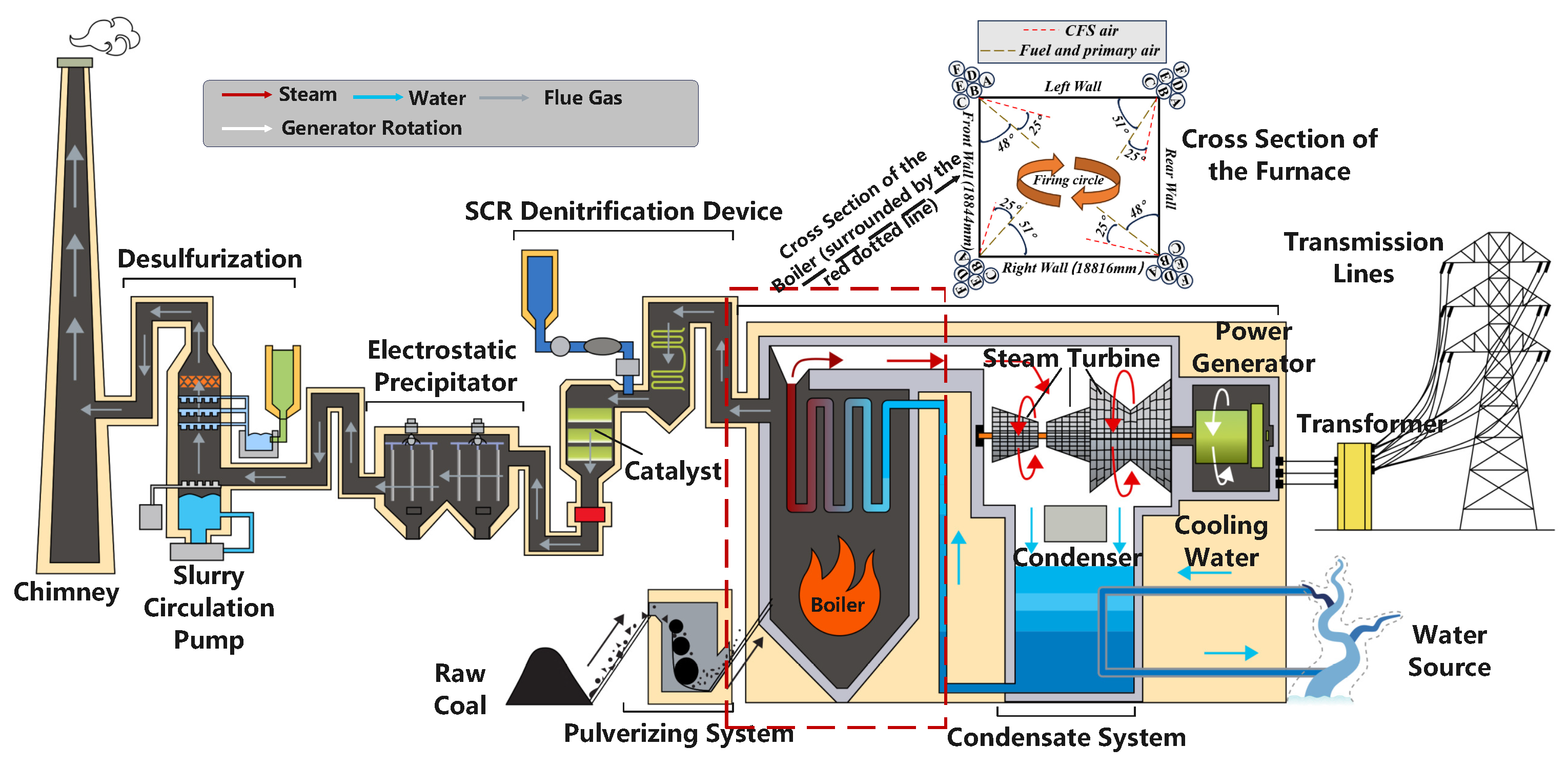
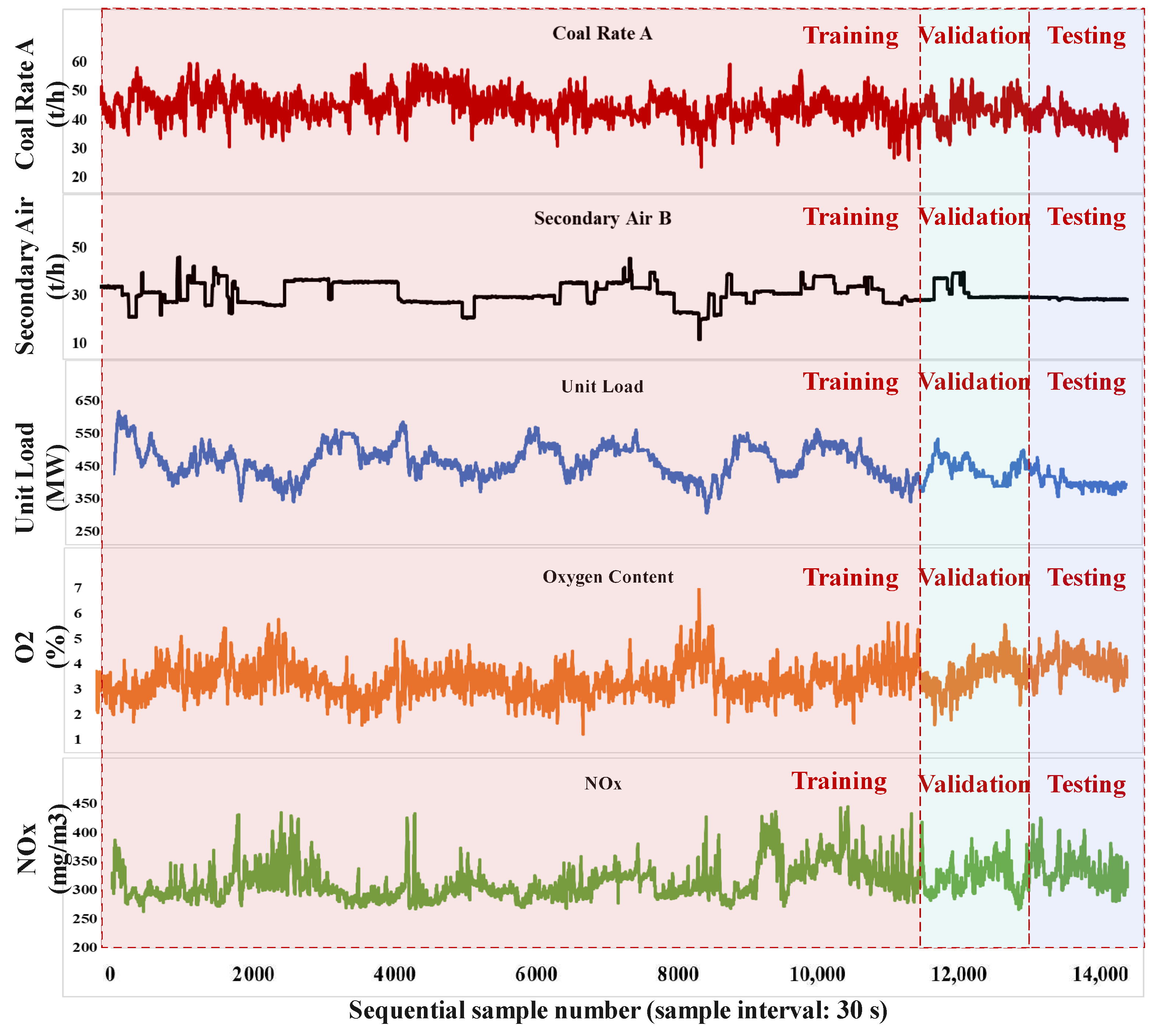
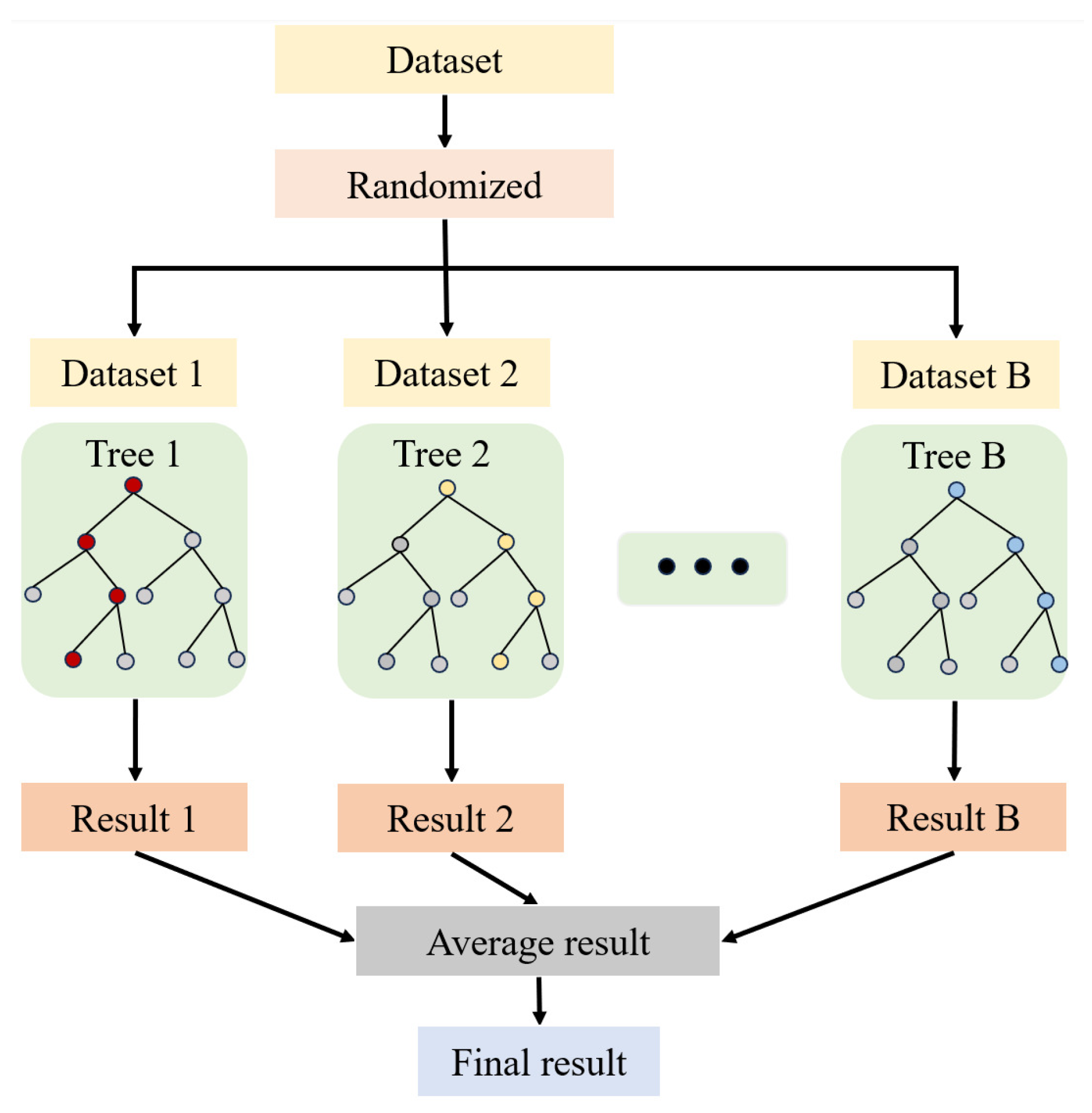
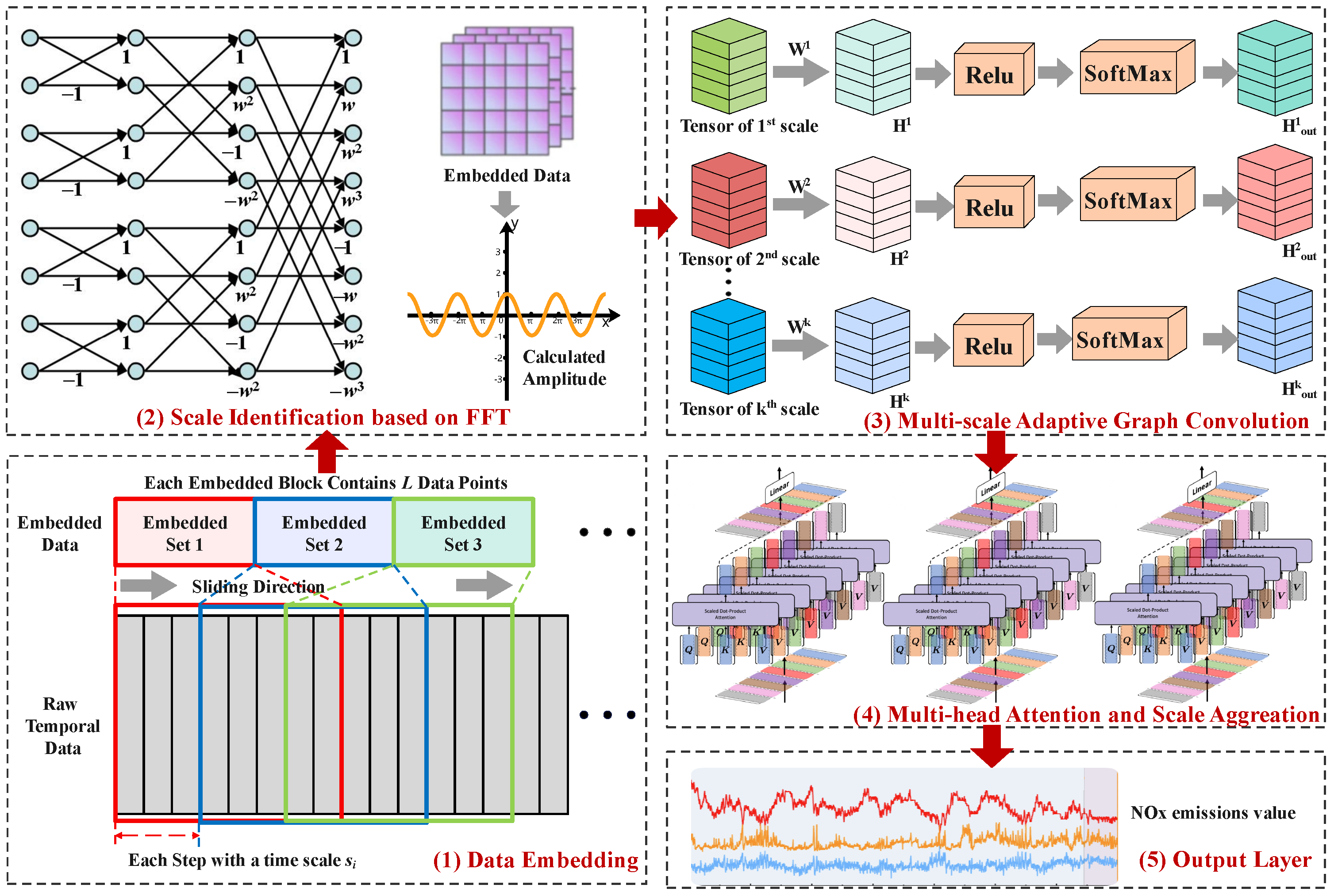
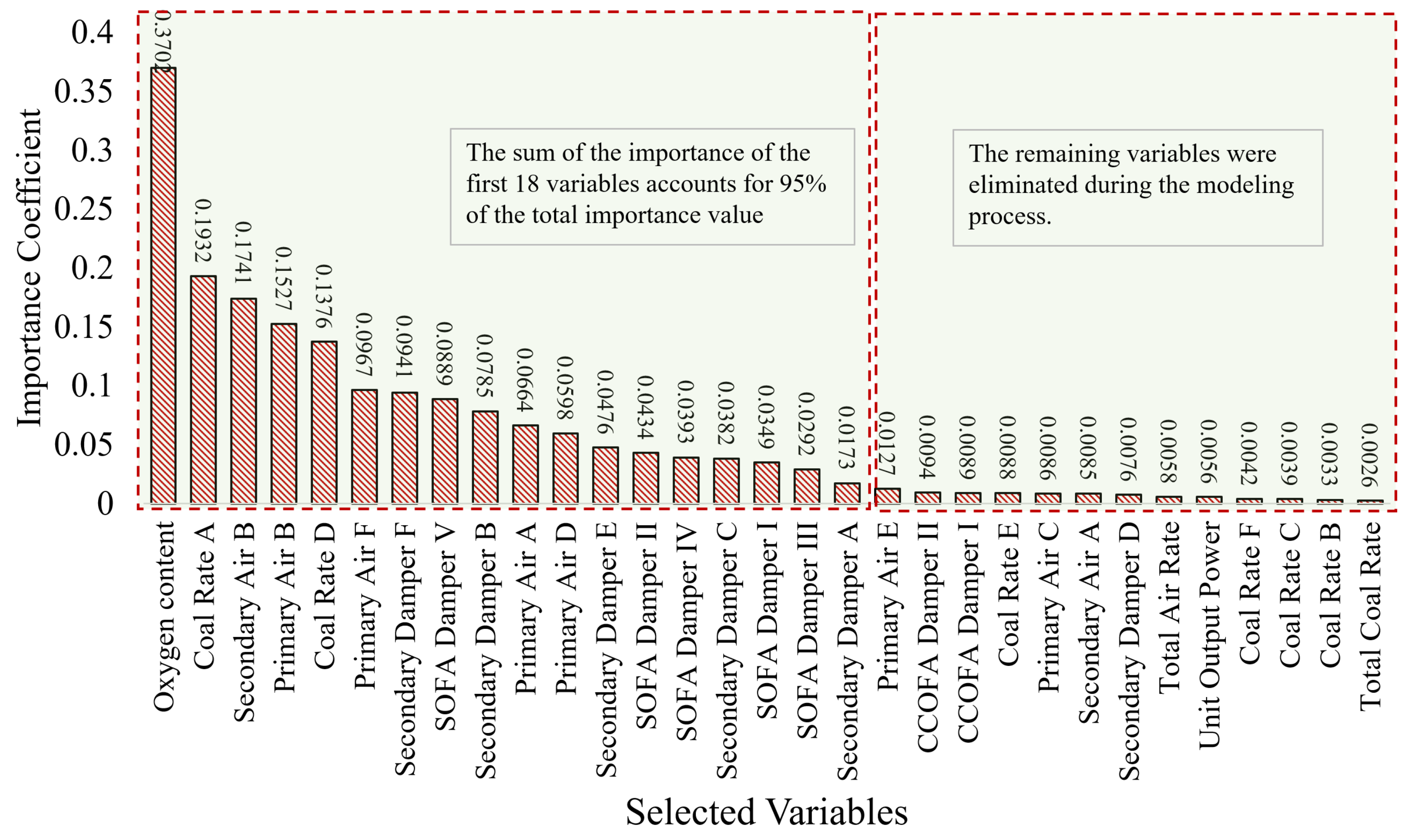
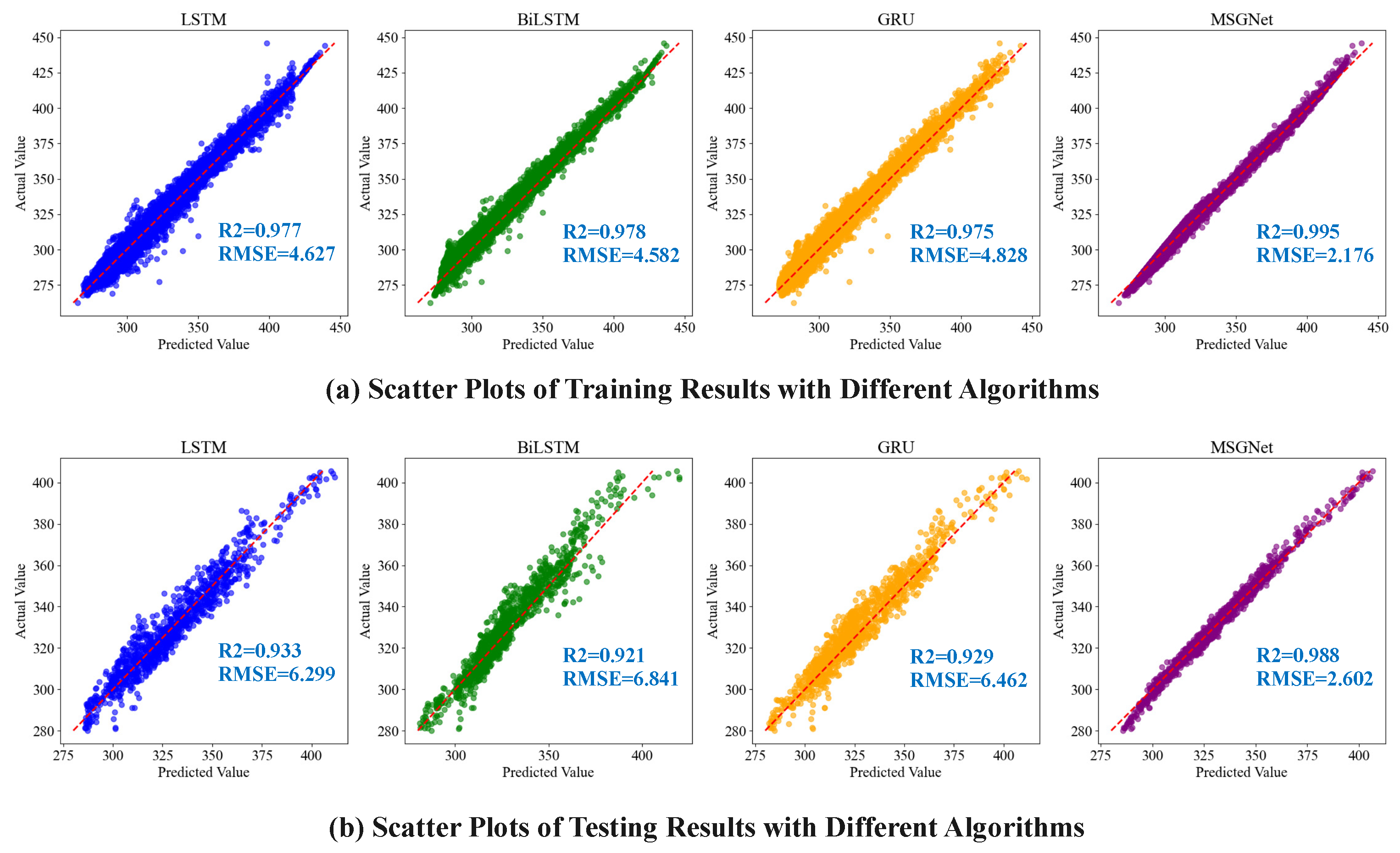
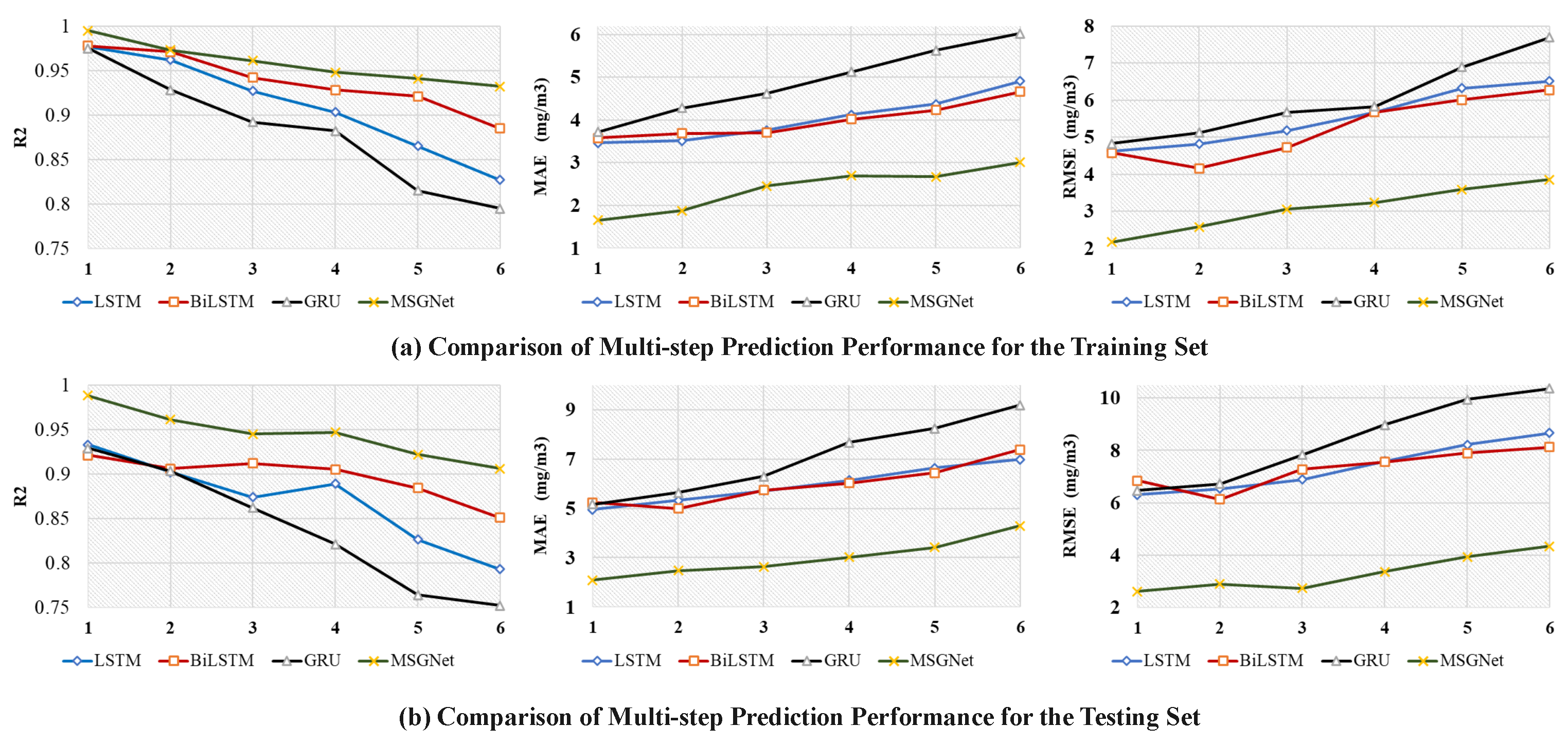
| Index | Variable | Unit | Description |
|---|---|---|---|
| MW | Unit output power | ||
| t/h | Total coal rate | ||
| t/h | Total air rate | ||
| O2 | % | Oxygen content | |
| x5–10 | t/h | Coal rate of each coal mill | |
| x11–16 | t/h | Primary air rate of each burner | |
| x17–21 | % | SOFA damper opening | |
| x22,23 | % | CCOFA damper opening | |
| x24–29 | % | Secondary damper opening | |
| x30,31 | t/h | Secondary air rate of each burner | |
| y | NOx | mg/m3 | NOx concentration |
| Model Description | Training Results | Testing Results | Training Time (s) | ||||||||
|---|---|---|---|---|---|---|---|---|---|---|---|
| R2 | MSE | RMSE | MAE | MAPE | R2 | MSE | RMSE | MAE | MAPE | ||
| Using Variables after RF | 0.995 | 4.733 | 2.176 | 1.652 | 0.526 | 0.988 | 6.771 | 2.602 | 2.093 | 0.635 | 131.6 |
| Using Original Variables | 0.987 | 4.873 | 2.209 | 1.701 | 0.603 | 0.972 | 7.048 | 3.021 | 2.532 | 0.724 | 225.4 |
| Algorithm | Training Results | Testing Results | ||||||||
|---|---|---|---|---|---|---|---|---|---|---|
| R2 | MSE | RMSE | MAE | MAPE | R2 | MSE | RMSE | MAE | MAPE | |
| LSTM | 0.977 | 21.412 | 4.627 | 3.462 | 1.099 | 0.933 | 39.68 | 6.299 | 4.954 | 1.502 |
| BiLSTM | 0.978 | 20.997 | 4.582 | 3.582 | 1.137 | 0.921 | 46.797 | 6.841 | 5.23 | 1.552 |
| GRU | 0.975 | 23.307 | 4.828 | 3.721 | 1.178 | 0.929 | 41.751 | 6.462 | 5.169 | 1.557 |
| MSGNet | 0.995 | 4.733 | 2.176 | 1.652 | 0.526 | 0.988 | 6.771 | 2.602 | 2.093 | 0.635 |
Disclaimer/Publisher’s Note: The statements, opinions and data contained in all publications are solely those of the individual author(s) and contributor(s) and not of MDPI and/or the editor(s). MDPI and/or the editor(s) disclaim responsibility for any injury to people or property resulting from any ideas, methods, instructions or products referred to in the content. |
© 2025 by the authors. Licensee MDPI, Basel, Switzerland. This article is an open access article distributed under the terms and conditions of the Creative Commons Attribution (CC BY) license (https://creativecommons.org/licenses/by/4.0/).
Share and Cite
Huang, J.; Ji, Y.; Yu, H. A Deep Learning Model for NOx Emissions Prediction of a 660 MW Coal-Fired Boiler Considering Multiscale Dynamic Characteristics. Atmosphere 2025, 16, 533. https://doi.org/10.3390/atmos16050533
Huang J, Ji Y, Yu H. A Deep Learning Model for NOx Emissions Prediction of a 660 MW Coal-Fired Boiler Considering Multiscale Dynamic Characteristics. Atmosphere. 2025; 16(5):533. https://doi.org/10.3390/atmos16050533
Chicago/Turabian StyleHuang, Jianrong, Yanlong Ji, and Haiquan Yu. 2025. "A Deep Learning Model for NOx Emissions Prediction of a 660 MW Coal-Fired Boiler Considering Multiscale Dynamic Characteristics" Atmosphere 16, no. 5: 533. https://doi.org/10.3390/atmos16050533
APA StyleHuang, J., Ji, Y., & Yu, H. (2025). A Deep Learning Model for NOx Emissions Prediction of a 660 MW Coal-Fired Boiler Considering Multiscale Dynamic Characteristics. Atmosphere, 16(5), 533. https://doi.org/10.3390/atmos16050533





